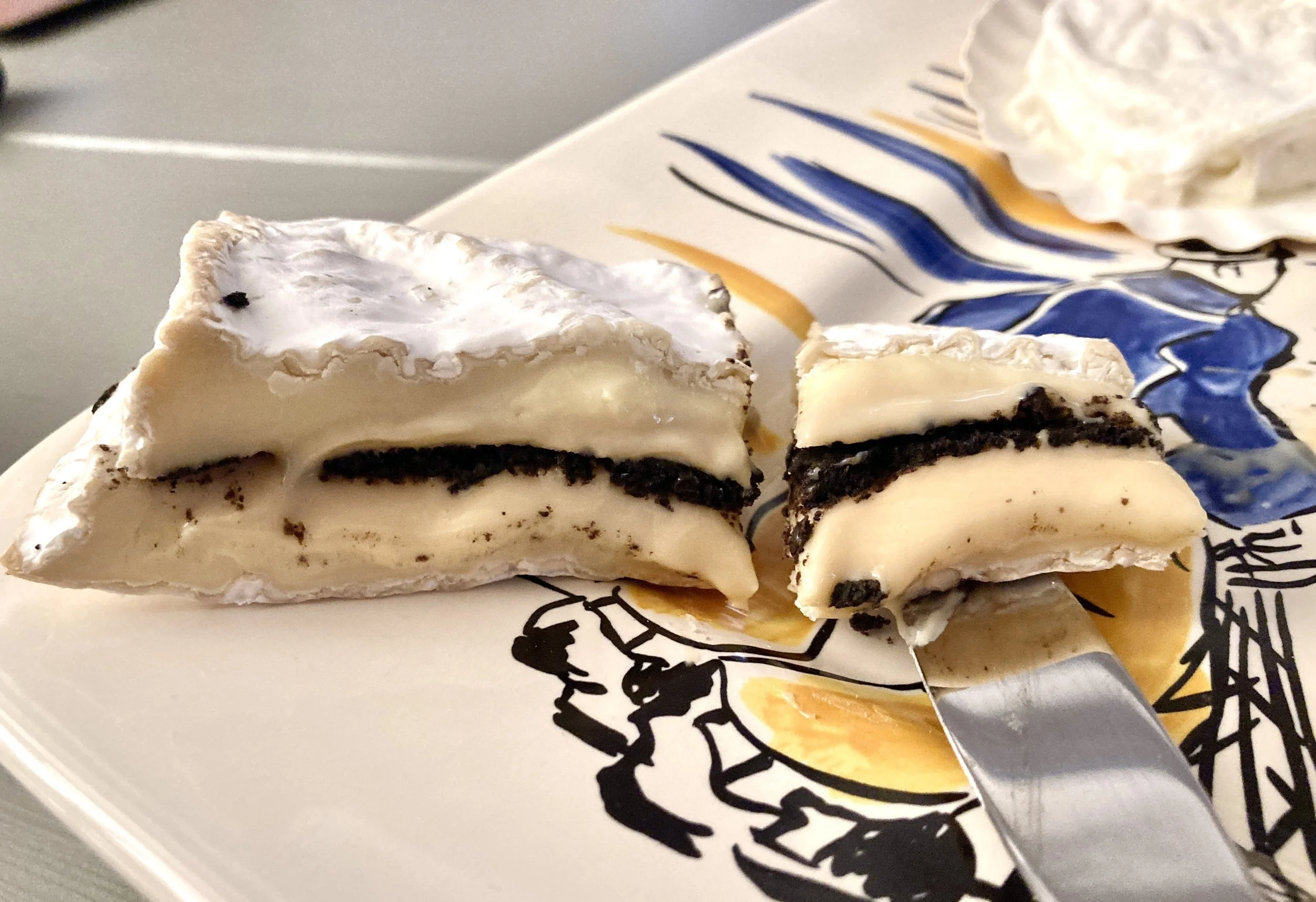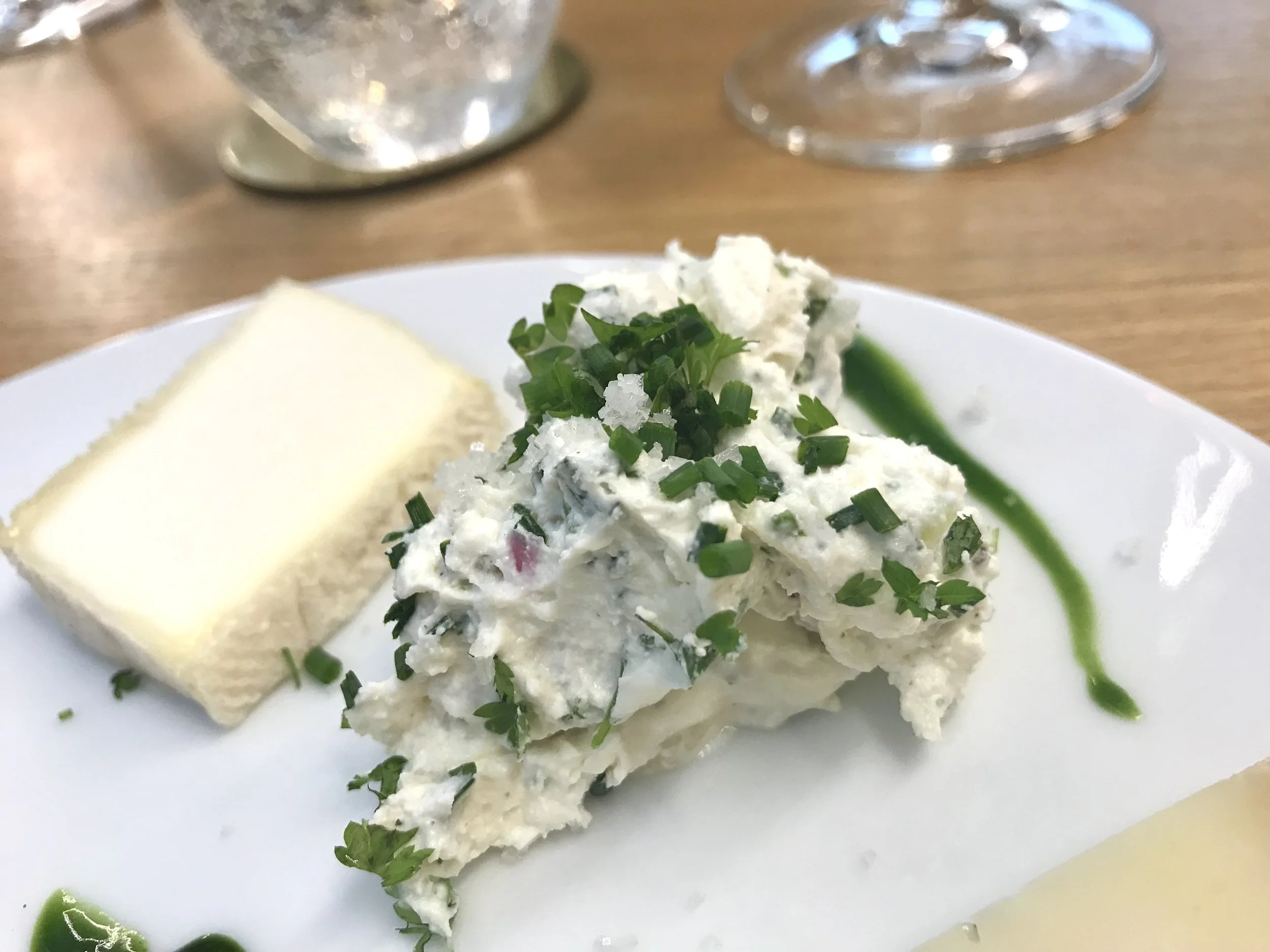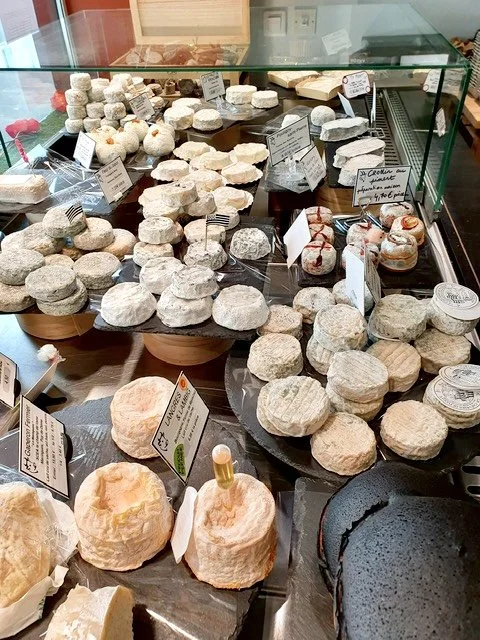French Cheese Etiquette Questions Answered
French President Charles de Gaulle was way off in 1962 when he famously asked, "How can you govern a country which has two hundred and forty-six varieties of cheese?"
There are so many different types of cheese in France that even if you tried one new cheese every day for a year, you’d not even be close to trying them all!
There is immense diversity within each variety of cheese, leading some to estimate between 1,000 and 1,600 distinct types of French cheese. So much to learn and taste but I’m making it my vow to try my best!
While in Brest last month for my husband’s art expo I wanted to stop at a cheese shop I saw online with really great reviews, Escale Fromagère. The opening night of his show the shop owner threw a little party for the occasion and they had gorgeous cheese platters for the guests to nibble on. You guessed it, the cheese shop that catered the party was the one I wanted to visit. All the locals at the party said that this was the best shop in Brest and shouldn’t be missed. I was fortunate enough to meet the owner that night and I told her I’d be back to see her on Saturday in her shop.
I knew I’d like the owner and the shop by the quote on their website:
“The only way to get rid of a temptation is to yield to it.”
France has so many quality things to splurge on (wallet or waistline)- pastries, purses, perfumes but my soft spot is cheese. While it's eaten practically every day in some form by everyone in France, it can be intimidating. I know for me I don’t want to make a cheese plate faux-pas while being a guest or hostess and it was comforting to hear from Carine Le Maillot, the owner of Escale Fromagère, that even French people have questions about cheese etiquette!
Opened in 2014, Escale Fromagère offers a selection of quality cheeses, mostly from local producers with whom it maintains close ties to guarantee an irreproachable and quality supply. In addition to their totally friendly and personalized advice, she develops cheese recipes according to the seasons (bonjour brie with truffles- je t’aime), and beautiful tailor-made platters for any type of gathering.
Carine worked for many years in the medical field but decided to do a professional reconversion and after doing years of professional training and internships she became a cheesemonger. Later becoming an artisanal cheesemonger and joining the prestigious Collège Culinaire de France in 2021. This is truly a labor of love for her. Plus her medical background comes in handy since owning any type of food shop (especially cheese… It’s Alive), requires meticulous cleaning, preparation, temperature control, etc. She believes that she spends at least 15 hours a week on sanitation alone.
I had a few burning questions for Carine who was extremely generous with her time. It was a Saturday afternoon (not the best time to interview a cheese shop owner) and people were coming into her shop in a constant flow, surely preparing for their weekend meals. Carine has a staff of very knowledgeable women who help clients find the perfect cheese for their needs and as I spoke with Carine I watched her visually greet her customers as they came in. It is a very welcoming and friendly cheese shop and it was obvious there are lots of regulars.
The first question I wanted to know was how many cheeses make up the perfect cheese plate and what types of cheeses.
How to Make the Perfect Cheese Plate
Since there are very few people who don't like cheese. You might think it is easy to choose the assortment, but there are so many cheeses, more or less strong/stinky/runny or from different animals that it is not an easy task to try to please everyone. Carine explained that you should offer cheeses of all different kinds and tastes for the cheese course. As a general rule a traditional cheese plate always includes these 5 varieties:
1) Pate cuite (Pressed and cooked cheeses) There are usually from mountainous regions and can be used in cooking. Some example are: Comté, Emmental and Gruyère. There are two types of cooked, pressed cheeses: cheese with an open pate (holes) like Emmental or closed pate (no holes) like Comté.
2) Pâte Molle et à Croûte Fleurie (Soft Cheese with Natural Rind) This is a soft cow’s milk cheese which has a white and floury surface. Some examples are: Brie de Meaux, Camembert fermier
3) Fromages à Pate Pressées (Pressed Uncooked Cheese) The particularity of this family of cheese is the diversity of the cheeses, but they all have one point in common which is the pressing of the curds while being drained. These are made from larger-cut curds that are heated gently at a lower temperature. This expels moisture (whey) from the curds, but not as much as a cooked cheese. Some examples are: Saint-Nectaire, Tommes, Morbier, Cantal
4) Fromage de Chèvre (Goat cheese) Some examples are : Saint-Maure de Touraine, Crottin de Chavignol and Pouligny-Saint-Pierre. There are officially over a hundred varieties of goat cheese in France.
5) Fromages á Pate Persillées (Blue cheese) These cheeses which you can recognize by their blue or green channels that run through it can have a strong flavor and smell. Usually, these cheeses are always made with cow milk but one of the most popular of them all is Roquefort and it is made with sheep’s milk! Some examples are : Roquefort, Fourme d'Ambert, Bleu de Gex, Bleu des Causses, Fourme de Montbrison, Bleu d'Auvergne, Stilton, Shropshire Blue
These five types of cheese are not exhaustive but it will offer an assortment that ensures everyone will like at least one of the cheeses on the board.
How many cheeses should you serve?
There is a tradition recommending always presenting your cheeses in odd numbers. Three is too few to really give a good variety so 5 is really the perfect number, but hey, why not 7,9,11….
When you are the guest at a dinner party and the cheese plate gets passed around or at a nice restaurant when they wheel over the cheese cart, many people have a small heart attack; first about how many to serve themselves and secondly OMG how to I cut it so as not to disfigure the whole arrangement?! I am happy to learn from Carine that correctly cutting the cheese is also a fear of many French people.
Being delighted by Eric Lefebvre, winner of Best Cheese Monger of France 2004. He is a 5th generation cheese monger. The title Meilleur Ouvrier de France is an esteemed award and it is retained for life.
As for quantity, if there are 5 you can feel free to take a small serving of each of them, or just take what you’d like. Here you are not limited to number of cheeses but etiquette says you shouldn’t have seconds of cheese. Since the cheese course is ALWAYS served after the main course and before dessert, the host or hostess might feel embarrassed that they didn’t see you enough to eat for the main course.
How to cut French cheeses
Jokes aside, cutting the cheese is serious business in France. The whole goal when you are slicing the cheese is to leave a little bit of the good cheese, not only the rind, for everyone. Think of a modified version of the French motto- Liberty, Equality, Fromage. Try to be equal in your dispersion on the rind.
Some cheeses are pretty instinctive- a round wheel of camembert you’ll cut it like a cake into triangle pieces.
This was a round goat cheese and I took a small triangle out of it.
For goat cheese or any others in a log shape, you slice it into cylinders.
It’s the other shapes that can get tricky- a triangular brie or a rectangular Comté, what do you do?
For a triangle of Brie- You first cut the tip off but on an angle. You keep cutting up on an angle till you are mid-way then you can cut perpendicular to the rind so that everyone gets a bit of the rind. This way no one is left with just a firm piece of rind at the end.
For Comté or other rectangular cheeses: the first to serve themselves must cut in the direction of the width (in order to have a piece of crust on each side). When two-thirds of the cheeses are already cut, the next ones will then have to cut the cheese perpendicular to the first ones (therefore lengthwise) so that they have a piece of crust on one side of the piece of cheese.
Carine introduced me to a new cheese. It was my first time trying Ol Sciur, an Italian raw goat milk cheese with hibiscus, berries and rose petals. This is considered a Pate Persilé. Incredible!
There is no set rule for making your cheese platter BUT France is a country that lives and dies by its traditions so it's best to follow them.
While looking at all the different varieties of cheeses before me at Escale Fromagère I noticed some butter that was the color of a bar of gold. It was a local Breton butter from Les Patureurs du Tonnerre. Butter is one of the things Bretagne is known for, cheese isn’t and I wondered why.
Carine told me it is because of two reasons- the type of cows in Bretagne and more suited for butter and because of the proximity to the ocean, meaning salt. In the past, the only breed that was found in Bretagne was the Pie Noir type of cow. They were small cows and the food they grazed on was of poor quality so the milk was rather “fatty”. It was more suitable for making butter or cream.
The only butter in Bretagne is salted-butter anything else is sacrilegious. Sailors required butter that was able to be well conserved and sea salt was readily available. But that’s not all, the love story between the Bretons and their salted butter goes even deeper. The real reason why Bretagne has the best salted butter is because of taxes! In the Middle Ages, the Duchy of Brittany enjoyed virtual independence from the Kingdom of France. After the union of 1532 (Francois I was married to Claude- the daughter of Anne de Bretagne), the province, represented by the States of Brittany, enjoyed a set of privileges. This region rich in salt marshes was exempt from the salt tax, the famous tax due to the Kingdom of France. So, in Bretagne, they put salt everywhere!
Until the Revolution (1789), this product rarely left the region, because marketing to other provinces was subject to taxation. In the 19th century, the Bretons produced a semi-salted butter that was 0.5 to 3% salt.
A good reason to eat cheese is you often get a history lesson!
Each cheese is the fruit of a heritage and the symbol of a past history. If cooked pressed cheeses like Comté are made in mountainous regions, this is not insignificant, it’s because at the time it was necessary to produce cheeses dense enough to be able to last all winter without having to go back down to the valley. Similarly, Abbey cheeses are often washed rind cheeses because next to the production of cheeses, the monks produced other products such as beer or liquor!
Look at the gorgeous raw milk cream. Just like buying wine, the French like to know where their food comes from. Here is listed the two type of cows used for the milk and the village they come from.
With over 1,000 varieties of cheese in France, you will never be bored! Every day its own cheese, a new discovery for your palate. Unlike other products, every year new cheeses appear at the dairy. I hope you will get to know a cheesemonger while in France- ask them all the questions you have and let them guide you in finding the right cheese for you.



































